Family therapy for addiction treatment: definition, types, goal, and benefits
Table of content
- What is family therapy?
- How does family therapy work?
- What are the types of family therapy?
- What are the stages of family therapy?
- Where is family therapy used?
- Is family therapy effective in treating addiction?
- How is family therapy done in addiction treatment?
- What are the techniques used in family therapy to treat addiction?
- What is the main goal of family therapy in treating addiction?
- What are the benefits of family therapy in addiction recovery?
- How many sessions are required for family therapy in addiction treatment?
- What does a typical family therapy session look like in addiction treatment?
- What is the role of the counselor in family therapy in treating addiction?

Family therapy is a psychotherapy focused on improving relationships and behavioral patterns within the family unit. It includes diverse methods with unique principles and techniques, addressing issues from individual to community levels. It is based on the concept that a family functions as a system of interrelated parts, where a change in one part impacts all others. It focuses on improving communication and resolving conflicts within the family system. It improves overall family dynamics and relationships.
Types of family therapy encompass structural family therapy, systemic family therapy, strategic family therapy, functional family therapy, narrative family therapy, family psychoeducational therapy, multidimensional family therapy (MDFT), and bowenian family therapy.
The main goal of family therapy in treating addiction is to enhance communication, resolve familial issues, and foster a healthier environment at home. Family therapy enhances recovery by fostering effective communication strategies, setting boundaries, identifying triggers, and planning for relapse prevention. This process strengthens relationships, improves coping mechanisms, and creates a more supportive environment, significantly increasing the likelihood of long-term recovery.
Benefits of family therapy include improved communication, conflict resolution skills, trauma resolution, substance use prevention, reduced isolation, enhanced relapse prevention, building a support system, and developing coping strategies. Overall, family therapy aims to strengthen the family unit, promoting better mental health and a more supportive family environment.
What is family therapy?
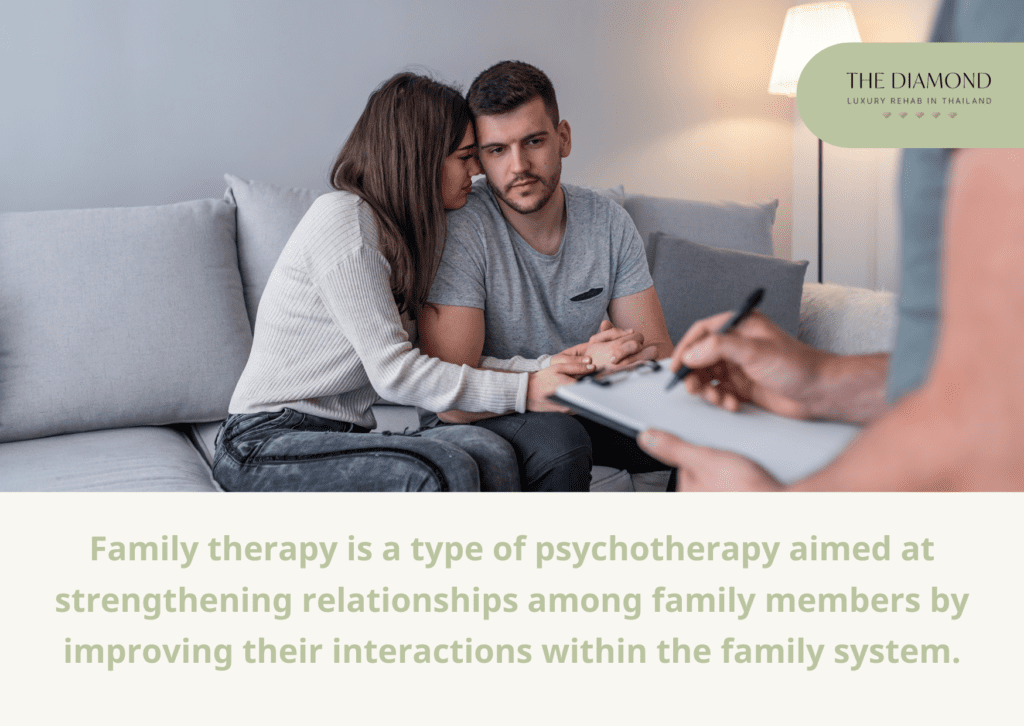
Family therapy is a type of psychotherapy aimed at strengthening relationships among family members by improving their interactions within the family system. Family therapy is typically brief and aims to achieve specific objectives. It involves the utilization of cognitive, behavioral, or interpersonal therapy approaches, with a primary emphasis on interpersonal therapy.
The chapter “Family Systems Theory” by Benjamin E. Johnson and Wendel Ray, published in the book The Wiley Blackwell Encyclopedia of Family Studies in 2016, outlines that family systems theory (FST) views the family as the main context where individual traits and behaviors are developed. FST links individual symptoms to family interaction patterns, emphasizing circular causality over linear. This theory focuses on observable interactions, highlighting how one member’s behavior influences others.
Family therapy examines the dynamics, tensions, and communication styles within the family unit, helping members manage conflicts, improve communication, and build stronger bonds with one another. By enhancing interactions among family members, it fosters positive changes in close relationships. This technique is especially effective when dealing with addiction, medical problems, or mental health diagnoses, as families frequently lack the expertise required to treat these situations.
In the article “Family Interventions: Basic Principles and Techniques” by Mathew Varghese et al., published in the Indian Journal of Psychiatry in 2020, it is noted that family interventions are typically initiated for various reasons such as marital problems, parent–child conflicts, sibling issues, the impact of illness on the family, adjustment difficulties, inconsistent parenting skills, and the need for psychoeducation about a patient’s illness. While these reasons generally prompt the referral, initial assessments uncover deeper, underlying issues within the family that emerge during further evaluations.
How does family therapy work?
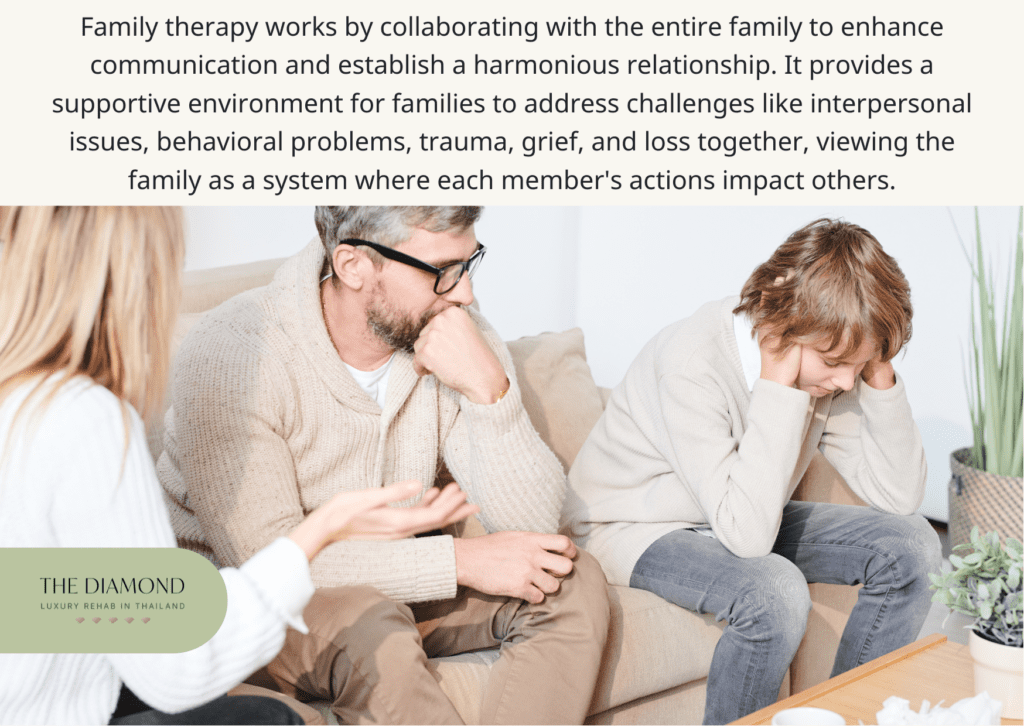
Family therapy works by collaborating with the entire family to enhance communication and establish a harmonious relationship. It provides a supportive environment for families to address challenges like interpersonal issues, behavioral problems, trauma, grief, and loss together, viewing the family as a system where each member’s actions impact others.
Therapists guide families in understanding these interactions, identifying unhealthy patterns, and replacing them with constructive behaviors, focusing on communication skills and conflict resolution to navigate disagreements productively.
Family therapy is used in numerous ways in the treatment of addiction. In family therapy sessions, the entire family meets with the therapist together, or only a portion of the family, like a couple or individual members, meets with the therapist, depending on the specific goals and dynamics of the family.
Each session is targeted to the family’s specific needs, which involve expressing thoughts and worries or practicing good communication and listening skills. In order to promote healing and enhance family relations, therapists employ various family therapy techniques depending on the problems being addressed.
While titles vary from a licensed family therapist, social worker, psychiatrist, psychologist, counselor, or clergy member, all family therapy leaders are licensed and professionally trained. Family therapy requires a distinct skill set compared to individual therapy. Therapists work at specialized centers or within treatment programs where the family member is receiving care. To address emergencies, families are typically provided with a 24/7 crisis hotline staffed by qualified professionals.
Overall, family therapy is a valuable tool for families facing diverse issues. Whether a family member is struggling with a mental health condition or the entire family is grappling with a life transition, therapy provides a safe space for open expression. Therapists work collaboratively with families to establish specific goals, by leveraging family strengths and fostering empathy, family therapy empowers families to create positive change in their relationships and individual lives.
What are the types of family therapy?

The types of family therapy are listed below.
- Structural family therapy: Structural family therapy, developed by Salvador Minuchin, emphasizes the organization of a family and the quality of interactions among its members. This widely used approach sees unhealthy family dynamics as a key source of stress and mental health issues. The 2019 article “Effectiveness of Structural–Strategic Family Therapy in the Treatment of Adolescents with Mental Health Problems and Their Families” by Lucía Jiménez et al., published in the International Journal of Environmental Research and Public Health, examines how this therapy addresses adolescent problems. It attributes these issues to family structural imbalances, dysfunctional hierarchies, and maladaptive reactions. The therapy aims to strengthen the parental subsystem, promoting a united front, and adjusting boundaries according to the family’s life cycle stage.
- Systemic family therapy: Systemic family therapy helps families uncover patterns in their behavior, understand the reasons behind them, and find ways to work together for a better outcome. This approach aims to create a healthy and supportive family environment. It is especially helpful for families facing challenges like severe mental illness or chronic conditions. This type of therapy looks at how family members’ problems are connected to their interactions with each other. It considers both the big picture of how the family works together and how each person feels about their role in the family.
- Strategic family therapy: This type of family therapy is characterized by its brief and straightforward approach compared to other techniques. The therapist in this method typically assigns tasks for the family to complete outside of the session. These assignments are designed to modify family dynamics by evaluating and refining communication patterns and decision-making processes within the family unit. In this therapy style, the therapist assumes an authoritative role, empowering family members who traditionally have less influence to communicate more efficiently within the family dynamic.
- Functional family therapy: This therapy focuses on prevention and intervention, primarily used to address high-risk youth and their families. This therapy is commonly employed for families dealing with behavioral problems or substance use disorders, aiming to assess family dynamics contributing to these issues and finding solutions to enhance communication and trust.
- Narrative family therapy: Narrative therapy helps families rewrite their stories. It focuses on the personal narratives each member creates from their experiences. By exploring and potentially revising these stories, families gain a deeper understanding of each other’s perspectives and challenges.
- Family psychoeducational therapy: Family psychoeducation works like a team effort between therapists, families, and individuals with serious mental illness. Therapists build trust and support with everyone involved. The goal is to educate families about the illness, treatment options, and how they best support their loved ones. Similar to physical health conditions like diabetes, mental illnesses are treatable and families learn practical ways to manage them effectively.
- Multidimensional family therapy (MDFT): MDFT is a versatile family therapy approach that tackles teen substance abuse and behavior problems. It combines individual counseling with strategies that involve the whole family and other key people in the teen’s life. This therapy looks at both the teen’s inner struggles and their interactions with others to understand and address the root causes of the problems.
- Bowenian family therapy: Bowenian family therapy emphasizes understanding family-of-origin emotional attachment patterns and unresolved separation issues to address substance abuse disorders. Instead of focusing on the parental generation, this approach helps adults and adolescents differentiate and define themselves as individuals by recognizing and reducing their lingering emotional entanglements. This process reduces the need for substance abuse as a means to deny their family-of-origin attachments, fostering healthier, more independent identities.
What are the stages of family therapy?
The stages of family therapy are listed below.
- Preparation stage: The preparation stage of family therapy involves several crucial steps. Initially, families acknowledge the significant impact of addiction on their functioning, which is essential for starting the therapeutic process. Next, they clearly identify the specific issues and behaviors related to addiction to understand its root causes and effects within the family context. Finally, setting realistic and mutually agreed-upon goals for treatment provides a roadmap for therapy sessions, ensuring that everyone is working towards common outcomes. Overall, the preparation stage lays the foundation for successful family therapy by fostering mutual acceptance, clearly defining problems, and formulating achievable goals.
- Transition stage: The transition stage of family therapy begins with the actualization of the crisis, where the family acknowledges and starts to face the immediate challenges posed by addiction. This involves defining the crisis in specific terms, allowing the family to understand the severity and impact of the situation. During this stage, families undergo a process of reformulation, essentially starting over and rethinking their approaches to handling the crisis. This includes changing previously held beliefs or strategies that were ineffective. Finally, acceptance plays a significant role, as family members come to terms with the reality of the situation and the need for change. This stage is vital for setting the groundwork for constructive therapeutic work and progress.
- Consolidation stage: This stage is marked by a collaborative effort to find effective strategies and approaches that lead to recovery and healthier family dynamics. This involves a collective agreement to invest time, effort, and emotional energy into the therapy sessions. The family works together to explore and evaluate different alternatives and solutions to the challenges posed by addiction. By investing in therapeutic work, the family demonstrates their dedication to supporting their loved one and improving their overall well-being.
- Termination stage: The final stage of family therapy involves planning and defining the process of ending the therapeutic relationship. This includes determining the duration and format of the termination phase. Universal issues that arise during this period are identified, and the therapist outlines specific tasks to address these issues, ensuring a smooth transition. Common problems encountered during termination are described and managed. As the family begins to heal from addiction, it’s crucial to disengage from therapy in a manner that empowers each family member to continue their journey toward recovery independently. This stage aims to provide the family with the confidence and skills needed to maintain progress and handle future challenges without ongoing therapeutic support.
Where is family therapy used?
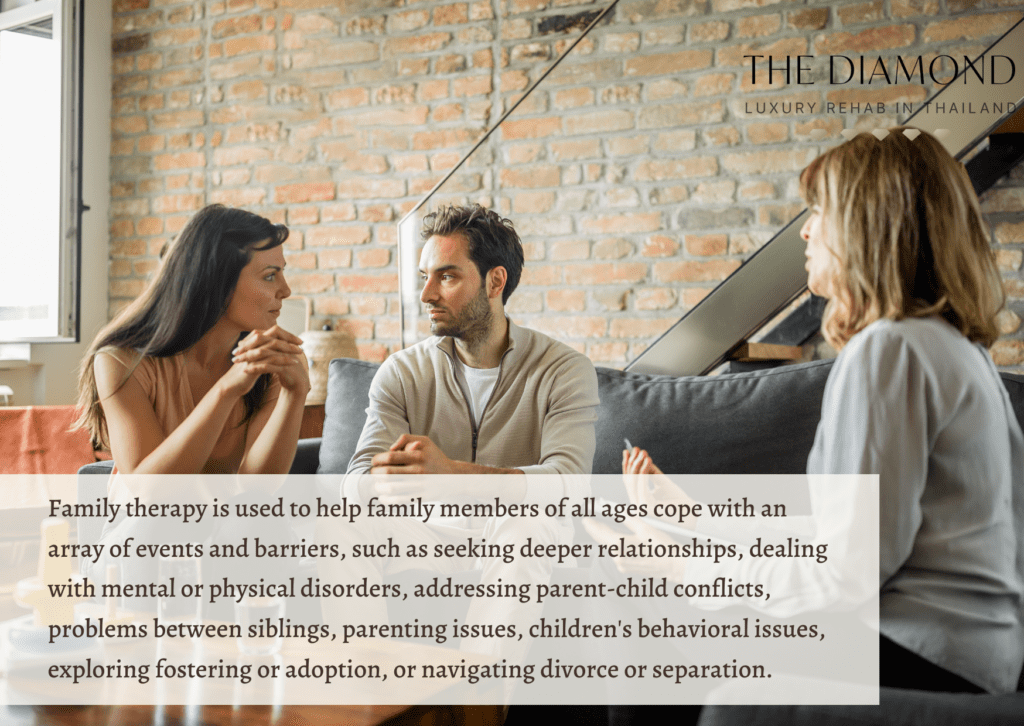
Family therapy is used to help family members of all ages cope with an array of events and barriers, such as seeking deeper relationships, dealing with mental or physical disorders, addressing parent-child conflicts, problems between siblings, parenting issues, children’s behavioral issues, exploring fostering or adoption, or navigating divorce or separation.
Additionally, it is used for those with issues including addiction, eating disorders, bipolar disorder, schizophrenia, depression, anxiety, brain disorders, and obsessive-compulsive disorder.
The article “Family Interventions: Basic Principles and Techniques” by Mathew Varghese et al., published in the Indian Journal of Psychiatry in 2020, explores the significance of family-based interventions in addressing various mental health disorders and substance addiction. For individuals with schizophrenia, the focus of these interventions is on reducing family expressed emotion (EE) and communication deviance, which contribute to stress and impede understanding. By enhancing family support and communication skills, these approaches aim to create a more nurturing environment that promotes symptom management and social functioning.
Similarly, for individuals with bipolar disorder, family interventions concentrate on early recognition of mood episodes and overall mood regulation. In the case of depression, family therapy works to address family conflict and low social support, integrating cognitive-behavioral and interpersonal techniques to improve coping mechanisms.
For anxiety disorders, a combination of family therapy and cognitive-behavioral approaches has shown efficacy in reducing anxiety symptoms by targeting maladaptive family dynamics and enhancing adaptive coping strategies.
Furthermore, in the treatment of addiction, incorporating family support has been found to enhance the patient’s coping abilities, mitigate negative impacts on relatives, and improve retention in therapy. The research emphasizes the critical role of family involvement in the management of various mental health conditions and substance addiction, highlighting the need for clinicians to adopt a comprehensive, family-centered approach to care.
Is family therapy effective in treating addiction?
Yes, family therapy is effective in treating addiction as it addresses the entire family, and not just the individual struggling with substances. By understanding addiction’s impact on family dynamics, communication, and behaviors, family therapy equips families with the knowledge and skills to cope effectively. While success depends on individual circumstances, family therapy, when combined with other treatments, is a valuable resource for families navigating addiction.
The article “Effects of family therapy for substance abuse: A systematic review of recent research” authored by Jessica Esteban et al., and published in the journal Family Process in 2023 demonstrates that incorporating family members into substance abuse treatment leads to positive outcomes, including reduced substance use and improved family dynamics.
How is family therapy done in addiction treatment?
Family therapy is done in addiction treatment through the involvement of the entire family to improve communication, address dysfunctional patterns, and support the individual’s recovery. It helps family members understand addiction, develop coping strategies and create a supportive environment for the recovering individual. Each family member is asked open-ended questions to understand their perspectives and goals, like “What would you like to see happen here?” or “What is your goal in coming here?”
The therapist educates the family about effective participation and key issues related to substance abuse. Feedback is provided to highlight common or differing goals among family members. Depending on the therapeutic approach, the session focuses on gathering information, affirming family members, or identifying and addressing constraints to change. For example, therapists practicing solution-focused therapy assign tasks to test the feasibility of change in specific areas.
Therapy isn’t confined to the walls of the therapist’s office. Therapists understand the importance of ongoing support and reinforcement. This takes many forms, such as alumni-led or counselor-run support groups. Therapists schedule check-ins with patients and families typically after 6 months or 1 year after treatment to address any new concerns that arise. Additionally, patients are encouraged to reach out for support whenever needed. The goal of this follow-up is to provide a lasting safety net, reinforcing the progress made in therapy and helping patients navigate future challenges.
What are the techniques used in family therapy to treat addiction?
The techniques used in family therapy to treat addiction are listed below.
- Behavioral techniques: Family therapy employs practical methods to teach families new skills. These methods include behavioral techniques, which involve understanding the problem and practicing skills through modeling. Modeling is a technique demonstrating behaviors, attitudes, or skills that patients learn and replicate. It is used by the therapist to exhibit healthy interactions, effective communication strategies, coping mechanisms, and problem-solving skills. Patients observe these demonstrations and are encouraged to imitate them in their own lives. This approach helps improve communication and tackle specific challenges like behavioral issues, emotional dysregulation, strained relationships, and enhancing problem-solving abilities. Behavioral techniques are often used for chronic psychotic conditions. The treatment is typically short-term.
- Psychodynamic techniques: This technique delves into how each family member views and reacts to problems. The therapist helps them gain deeper emotional understanding by exploring new perspectives and more effective responses. Through analyzing family interactions and defense mechanisms, the therapist aims to improve emotional awareness. This approach typically lasts 15-30 sessions. It requires the psychological mindedness of the patient and being able to understand dynamics and interpretations. A strong and consistent level of motivation is essential for this type of therapy. It has been particularly effective for couples experiencing marital discord, especially those from upper-middle-class backgrounds. However, the time commitment is a significant limitation.
- Structural techniques: This method aims to help family members manage boundaries and power dynamics. Techniques like establishing new boundaries and routines enhance family functioning. The 2020 article “Family Interventions: Basic Principles and Techniques” by Mathew Varghese et al., published in the Indian Journal of Psychiatry, discusses the popularity of structural techniques among therapists in India. This approach has gained traction due to the clear subsystems within Indian families, which include parents, children, and grandparents. These subsystems facilitate the identification and modification of family structures. Additionally, many patients exhibit misconduct and personality disorders during adolescence and early adulthood. Techniques like unbalancing and boundary-making are effective in addressing common issues like adolescent power struggles and marital conflicts, benefiting numerous patients.
- Strategic techniques: Strategic techniques are employed in family therapy for difficult and resistant families, particularly when other methods have not succeeded. Techniques like reframing and positive connotation are effective in facilitating change. Therapists are well-versed and proficient in these methods, ensuring that therapy is typically brief and concludes efficiently with clear recommendations.
What is the main goal of family therapy in treating addiction?
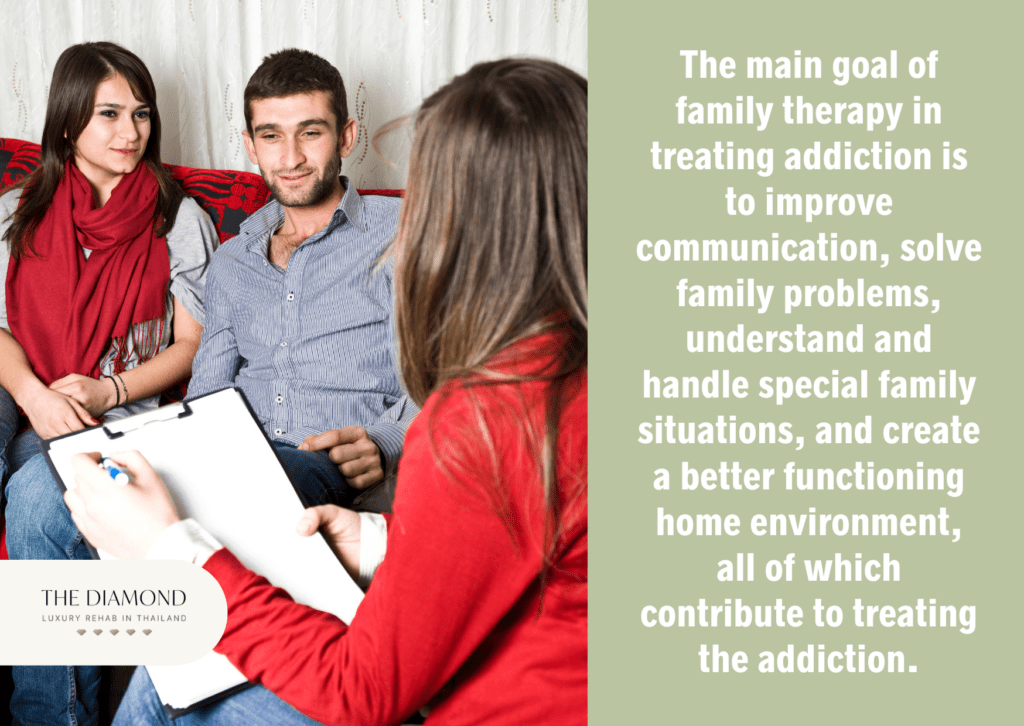
The main goal of family therapy in treating addiction is to improve communication, solve family problems, understand and handle special family situations, and create a better functioning home environment, all of which contribute to treating the addiction.
The manual titled “Family Therapy Can Help For People in Recovery from Mental Illness or Addiction” published by the Substance Abuse and Mental Health Services Administration (SAMHSA) in 2013, highlights the dual focus of family therapy in addiction recovery, supporting the individual’s sustained recovery and bolstering the emotional well-being of the entire family unit. These goals are recognized as adaptable, allowing each family to prioritize and address specific issues as they see fit throughout the therapeutic process.
Family therapy assists in the recovery process by helping family members develop effective communication and support strategies. This includes setting boundaries, identifying triggers, and creating a relapse prevention plan together. It focuses on enhancing family dynamics by addressing the impact of addiction on relationships. Family members gain a better understanding of addiction, learn to manage their own emotions such as anger, guilt, or fear, and develop healthier coping mechanisms. This results in improved communication, stronger relationships, and a more supportive home environment for the person in recovery. By achieving these goals, family therapy aims to increase the chances of long-term recovery for the individual with addiction and create a healthier family unit overall.
What are the benefits of family therapy in addiction recovery?
The benefits of family therapy in addiction recovery are listed below.
- Improved communication: Family therapy is valuable for improving communication within families. Therapists use different techniques to facilitate open and understanding communication. These sessions offer a safe space for expressing feelings without judgment, promoting transparency and reducing misunderstandings. This is especially beneficial for families struggling with conflicts or emotional distance due to communication issues.
- Conflict resolution skills: Addiction often causes conflicts within families, leading to broken trust and heightened emotions. Family therapy teaches conflict resolution skills, helping members navigate disagreements constructively and rebuild trust. Therapists identify underlying causes of conflicts and teach positive resolution methods, fostering harmonious resolutions. These skills benefit not only family dynamics but an individual’s ability to manage conflicts in other areas of life.
- Trauma resolution: Addiction typically stems from unresolved family trauma, which is addressed through family therapy. According to the article “Stemming the Tide of Trauma Systemically: The Role of Family Therapy” by Prof. Charles R. Figley and Kathleen Regan Figley, published in the Australian and New Zealand Journal of Family Therapy in 2013, family therapy provides a safe space to explore and heal trauma within the family system. The article highlights the importance of systemic thinking in understanding and treating trauma, offering a protocol for trauma-informed practice.
- Substance use prevention: By addressing underlying family dynamics and fostering healthy communication, therapy not only supports the recovery of the initial user but reduces the risk of substance use for other family members.
- Reduced isolation: Addiction frequently leads to isolation in individuals and discord within families. Family therapy helps build connections and a sense of belonging, thereby alleviating these feelings of isolation for both the individual and their family members. The article “Emotional and Social Loneliness in Individuals With and Without Substance Dependence Disorder” by Mohsen Hosseinbor et al., published in the International Journal of High Risk Behaviors and Addiction in 2014, highlights that social and emotional loneliness is a significant risk factor for the initiation and maintenance of drug abuse.
- Enhanced relapse prevention: Increased awareness of the warning signs of relapse is a significant benefit of family therapy. By involving family members in the treatment process, they become more attuned to the behaviors and patterns that indicate a potential relapse. This heightened awareness allows for early intervention and support, which help prevent a full relapse and support the individual in maintaining their recovery.
- Building support system: Family therapy builds a stronger safety net for someone recovering from addiction. It teaches them to leverage the strengths and resources of their family for ongoing support. Family members, in turn, learn how to be active participants in their loved one’s long-term journey. This includes understanding relapse, its triggers, and how to be a source of strength through relapse prevention plans.
- Developing coping strategies: Family therapy helps families create effective coping strategies to manage stress and challenges. Therapists guide families in recognizing stressors and developing practical solutions, fostering resilience. These strategies not only address immediate issues but equip family members with skills to handle future difficulties together, promoting long-term emotional health and stability.
What are the cons of family therapy for addiction treatment?
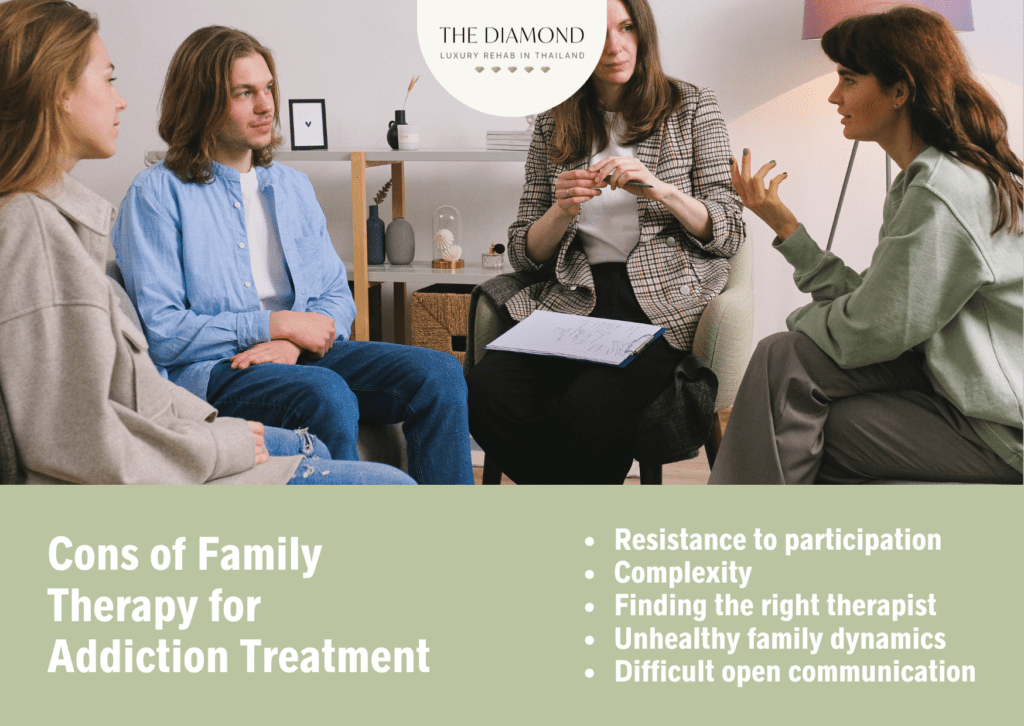
The cons of family therapy for addiction treatment are listed below.
- Resistance to participation: Not everyone feels comfortable discussing personal issues in a family setting. Family members resist therapy altogether, making it difficult to achieve the full benefits. This is due to feelings of shame, anger, or simply not understanding how therapy works.
- Complexity: Family therapy adds layers of complexity compared to individual or group settings. While individual therapy focuses on one person, and group therapy brings together unrelated individuals, family therapy involves a pre-existing group with a rich history. This group has its own dynamics, communication patterns, and established roles – like a pre-formed team that the therapist needs to navigate. It’s almost like the therapist is stepping into an existing group therapy session, but with members who have years of built-up interactions and emotional baggage.
- Finding the right therapist: Two challenges hinder families from accessing optimal addiction treatment. Firstly, locating therapists with training in both addiction and family therapy is difficult, restricting treatment choices for families seeking this particular approach. Secondly, while effective, manualized family therapy programs (which have specific steps and materials) are not commonly utilized. This is because of the expenses associated with training and maintaining certifications, the rigid structure of these programs that do not suit all families, and the continuous effort required to ensure staff are trained and certified.
- Unhealthy family dynamics: When addiction is present, unhealthy family dynamics often arise. Enabling behaviors, such as providing money for drugs, making excuses, paying bills, or lying, stem from a desire to protect loved ones. However, these actions perpetuate addiction. Alternatively, family members express anger and disapproval, further straining relationships.
- Difficult open communication: In family therapy, not all members feel at ease expressing their thoughts. Unlike individual therapy, family sessions lack the privacy of one-on-one interactions, as discussions are typically shared with the entire family. This lack of confidentiality makes individuals hesitant to share their thoughts, feelings, and grievances during these sessions.
- Emotional dysregulation: Family therapy often involves discussing deeply personal and distressing issues, leading to emotional discomfort and increased stress. This process intensifies emotional turmoil before visible improvement, overwhelming individuals and prompting them to withdraw from therapy.
How many sessions are required for family therapy in addiction treatment?
Sessions required for family therapy in addiction treatment consist of 6 to 10 sessions, as evidenced in the chapter “Brief Family Therapy” of the book Brief Interventions and Brief Therapies for Substance Abuse Treatment Improvement Protocol (TIP) Series, No. 34 published by Substance Abuse and Mental Health Services Administration (SAMHSA). The preferred frequency is no more than two sessions per week, except in residential settings. This schedule allows individuals and families the time needed to practice new behaviors and experience meaningful change.
In residential treatment programs, the structure and content of family therapy sessions depend on the program’s design and duration. Programs incorporate dedicated “family weeks” in addition to individual therapy, while others mandate that patients engage a significant other for one or two nights each week to address recovery challenges jointly. Adolescent treatment programs typically maintain continuous family involvement throughout the treatment period.
How long does a session of family therapy last?
A session of family therapy lasts typically between 1.5 to 2 hours. This duration allows for deeper exploration of issues and implementation of therapeutic techniques. The article “Family Interventions: Basic Principles and Techniques” by Mathew Varghese et al., published in the Indian Journal of Psychiatry in 2020, describes how the duration of family therapy sessions varies depending on the phase and specific needs of the family. The process begins with an initial intake assessment session, lasting 20 to 30 minutes, where the therapist reviews the family’s information, understands their view of the problem, evaluates their motivation for therapy, and sets up an informal contract outlining the therapy methods and roles.
Following this, the family assessment phase typically involves 3 to 5 sessions, each lasting 45 minutes to an hour. During these sessions, the therapist assesses different aspects of family functioning and interactions, constructs a three-generation genogram, explores the family life cycle stages, problem-solving abilities, and draws a structural map.
The middle phase of therapy involves short-term interventions depending on the chosen therapeutic approach, such as strategic, psychodynamic, behavioral, or structural therapy. The duration and number of sessions in family therapy are tailored to address the specific issues and dynamics of the family, ensuring a comprehensive and effective treatment plan.
Lastly, the termination phase lasts a couple of sessions and reviews initial therapy goals with the family, highlighting the achievements and emphasizing the importance of maintaining new patterns. After therapy ends, families set new goals for the coming months. They review progress after a couple of months and have booster sessions after 6-12 months for sustained change and smooth transition.
What does a typical family therapy session look like in addiction treatment?
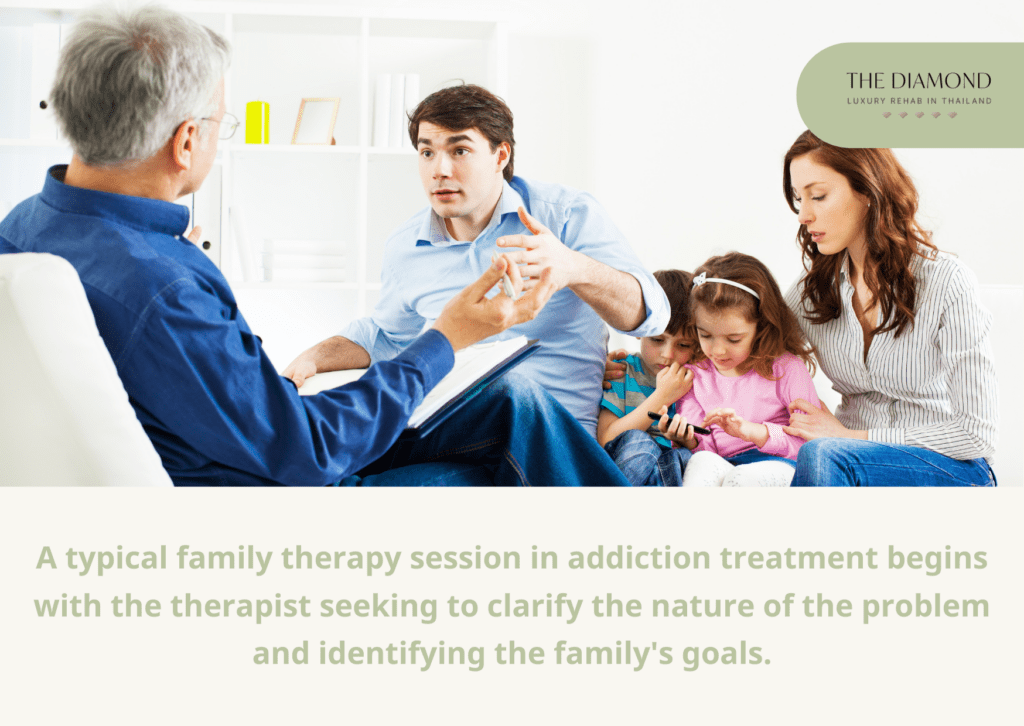
A typical family therapy session in addiction treatment begins with the therapist seeking to clarify the nature of the problem and identifying the family’s goals. Initially, it involves the individual struggling with addiction identifying who they consider as family and who they want to be involved in the process, which includes non-biological relationships that are significant to them.
The Substance Abuse and Mental Health Services Administration (SAMHSA), published a manual titled “Family Therapy Can Help For People in Recovery From Mental Illness or Addiction” in 2013, which explains that family therapy involves the entire family meeting together, though sometimes only part of the family attends. Though it is not common, the family therapist occasionally works one-on-one with a specific family member in addition to the family sessions.
Sessions typically last about an hour and occur at a clinic, the therapist’s office, or occasionally in a family member’s home. The session’s focus is on the person in treatment, another family member, or the family as a whole.
The therapist encourages family members to sign a contract before the first session, which includes commitments to specific behaviors like maintaining individual therapy or refraining from interjecting. A consent document that outlines privacy and confidentiality policies is signed by family members. Everyone, including the therapist, is expected to respect the confidentiality of what is stated during each session and not disclose it outside of the group, with exceptions explained in the consent form and by the therapist.
During the session, the family therapist asks questions or listens and observes while others speak to learn about how family members behave and communicate with one another, as well as identify the family’s strengths and needs. Depending on the family’s willingness for change and the individual receiving treatment, the therapist’s approach will vary.
The family therapist refers the entire family or individual members to additional sources of assistance, such as individual counseling, mutual-help groups, or classes on parenting or anger management.
Can family therapy be conducted online?
Yes, family therapy can be conducted online as it breaks down barriers to getting help, like distance, cost, and even trouble with finding transportation. Online sessions offer the same benefits as traditional therapy, with the added convenience of attending from the comfort of your own home. This proves especially helpful for families with busy schedules or those geographically dispersed.
A research review titled “Exploring the Efficacy of Telehealth for Family Therapy Through Systematic, Meta-analytic, and Qualitative Evidence” authored by Siân A. McLean et al., published in the journal of Clinical Child and Family Psychology Review in 2021, examined the effectiveness of online therapy, known as telehealth (TH) for families. Their findings suggest that TH is just as good as traditional in-person therapy for family therapy and treating parental depression. Additionally, the review showed that online therapy is adapted to maintain the core aspects of family therapy. Overall, this research strongly supports using online therapy for family therapy.
Can family therapy be effective if not all family members are involved?
Yes, family therapy can be effective if not all family members are involved. The therapy focuses on those present, improving their communication and relationships within the family system, leading to positive changes that affect the entire family. While full family participation is ideal, it’s not always necessary for successful therapy. A skilled therapist adjusts the approach based on the specific situation and the needs of those involved.
The therapist begins by determining which family members are crucial to the therapy process and need to be present during sessions. Sometimes it is helpful to include all family members at the start and as the therapy progresses it becomes evident that not all family members need to be present in every session. This approach allows the therapist to focus on specific issues or dynamics without overwhelming the therapy with unnecessary participants.
On the contrary, in cases of domestic violence or abuse, including specific family members is harmful, as it endangers the victim further. Therefore, therapists prioritize the safety and well-being of the patients involved.
What is the role of the counselor in family therapy in treating addiction?
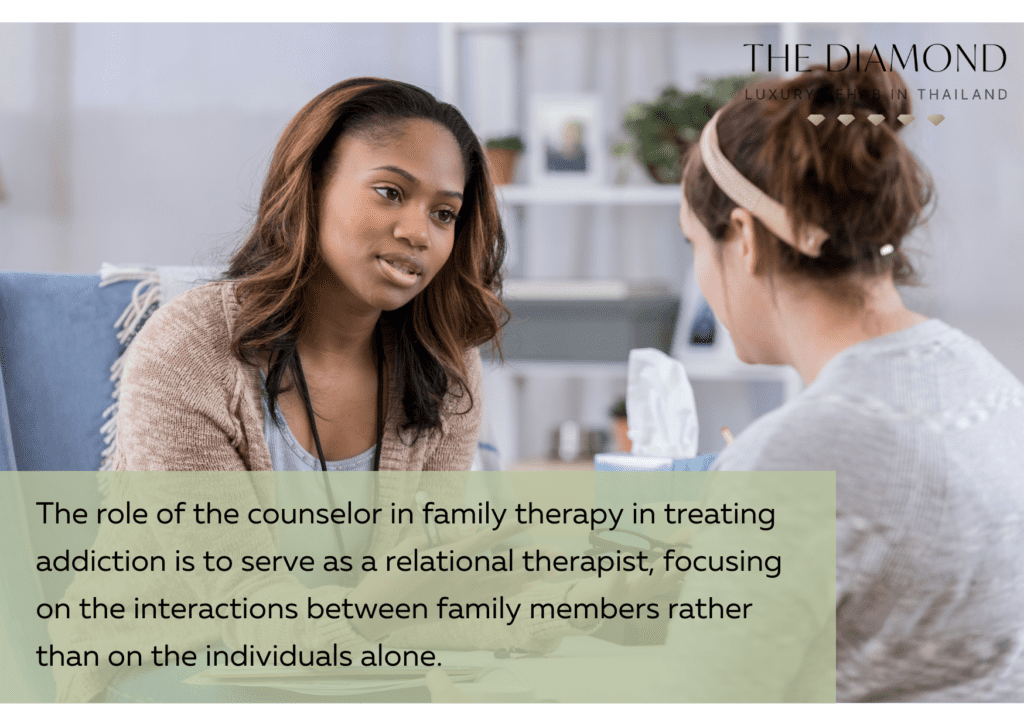
The role of the counselor in family therapy in treating addiction is to serve as a relational therapist, focusing on the interactions between family members rather than on the individuals alone. Counselors analyze specific instances of conflict by reviewing past incidents and suggesting alternative responses, or by addressing the underlying sources of conflict at a more abstract level. This involves pointing out patterns of interaction that the family has not noticed.
The article “Family Interventions: Basic Principles and Techniques” by Mathew Varghese et al., published in the Indian Journal of Psychiatry in 2020, emphasizes a solution-oriented approach to family therapy. This approach prioritizes resolving and managing problems collaboratively, rather than solely focusing on identifying a singular cause.
Counselors often utilize a “circular” approach, particularly within systemic therapies, to facilitate family members’ recognition of established behavioral patterns. By understanding the underlying causes of these patterns, families then work together to develop solutions for improvement. This approach proves advantageous as it avoids assigning blame and instead fosters a sense of collective responsibility and understanding within the family unit.
The counselor plays a crucial role in supporting families struggling with addiction. Their primary focus is on fostering healthy family interactions, even in the face of complex challenges like chronic mental health conditions or personality disorders. For particularly difficult cases, specialized family therapy techniques are implemented by specially trained therapists.


